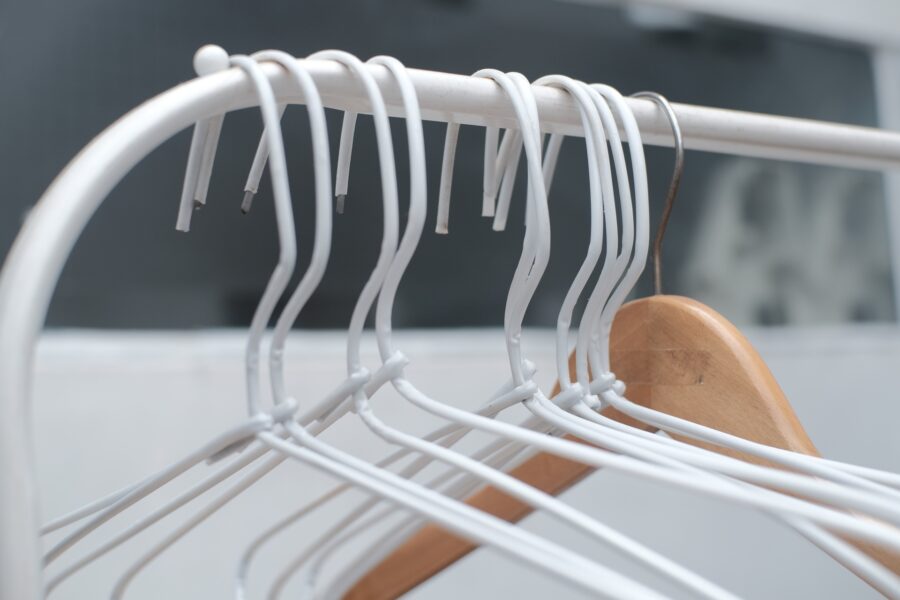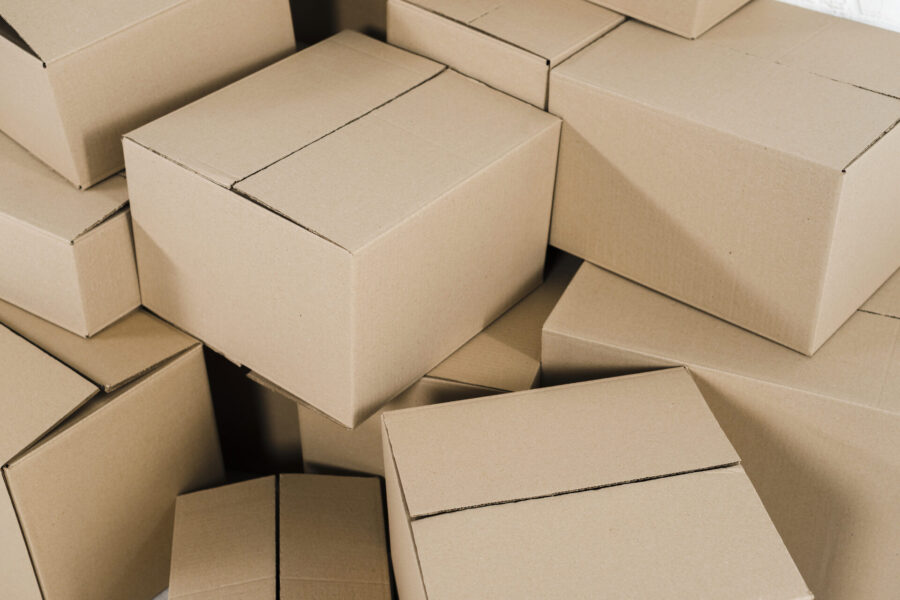

Expert Advice on How to Pack Hangers for the Move
Posted in How-to,Planning the Move on July 25, 2023
Ensuring the safe transportation of your belongings is the most important step when moving across the country. Whether you’re relocating to a new home or traveling, learning how to pack hangers for moving will help you keep your wardrobe in order and make the transition as smooth as possible. So, here are some invaluable tips and tricks provided by experts, guiding you on how to pack hangers in a box effectively and ensure they arrive at your destination ready to use.
When packing hangers for a move, it’s important to consider their specific needs. Sorting, labeling, and organizing them will facilitate an easier unpacking process. Bundling, using garment bags or boxes, and providing extra protection are all effective strategies. Whether you leave clothes on or pack them separately depends on the distance and your comfort level. Hiring professional cross-country movers can make the entire process smoother and more convenient.
Sort and Declutter Hangers
Before you begin packing, it’s essential to sort through them and declutter. Over time, hangers can accumulate and take up unnecessary space in your closet. Take this opportunity to assess each hanger and decide which ones are worth keeping and which ones can be discarded.
Start by separating them based on their condition and functionality. Inspect them for any damages, such as broken hooks or warped shapes, and set aside the ones that are no longer usable. Next, consider if you genuinely need all of them.
Often, we accumulate more than we actually need, so take the chance to downsize your collection. Get rid of everything that is excessive or unnecessary, freeing up valuable space for other items during the relocation. Remember, the goal is to streamline and simplify, so only keep items that serve a purpose and bring value to your wardrobe.
Decide Which Hangers Are Worth Keeping for the Move, and Donate the Rest
Once you go through all of them, it’s time to decide which ones are worth keeping for the relocation. Consider the quality and durability of each hanger, as well as their suitability for your clothing items. Sturdy ones made of materials like wood or plastic are ideal for protecting your clothes during transit.
Additionally, look for features like notches or clips that can securely hold items like pants, skirts, or delicate fabrics. Assess the number of hangers you’ll need based on the size of your new closet or storage area. While it’s tempting to keep all of them, remember that long-distance moving presents an opportunity to start fresh and minimize clutter.
If you find yourself with a surplus of items even after selecting the essentials, consider donating the rest to local charities, shelters, or thrift stores.

Get Packing Supplies
To ensure the safe and organized packing of your belongings for a relocation, it’s important to gather the necessary packing materials. Here’s a list of essential items and specialized supplies you’ll need:
- Boxes – Choose sturdy, appropriately-sized boxes. Opt for ones that are clean and in good condition. Medium-sized boxes are usually a good choice, but consider the number of items you have and select boxes accordingly. If you’re on a tight relocation budget, you can find free boxes by asking people or getting them from online sites like Craigslist.
- Garment bags – Garment bags provide an extra layer of protection. Use them to cover your hanger and clothing items to shield them from dust, dirt, and potential damage and relocation mistakes during shipping.
- Hanger boxes – These boxes are specifically designed to hold a hanger securely during transportation. They typically have built-in hanger slots or racks that allow you to hang them directly inside. They provide excellent protection and make unpacking a breeze, as you can transfer everything directly from the box to the closet.
- Rubber bands or zip ties – To prevent items from getting tangled or falling off during transit, use rubber bands or zip ties to secure groups together. This will keep them organized and minimize the chances of damage.
Prepare Hangers for Packing
This is an essential step when it comes to relocating or organizing your closet. Properly handling and securing your hangers ensures their safe move and makes unpacking a breeze. From removing clothes to assessing their condition, there are several key tasks to consider.
Group Hangers by Type or Category
Sorting your items by type or category is a practical approach to organizing them for easier unpacking and arrangement. Begin by sorting them based on size, material, or purpose. Separating them by size ensures that you can quickly locate the appropriate hanger for different clothing items, avoiding the hassle of searching through a mixed assortment.
Sorting them by material, such as plastic, wood, or metal, allows for efficient packing, as each material may require different handling or protection. Furthermore, grouping hangers by purpose, such as separating those for shirts, pants, skirts, or dresses, enables you to unpack and hang items according to specific categories. This method not only simplifies the unpacking process but also facilitates arranging your closet in a logical and organized manner.

Employ Different Packing Techniques for Different Hanger Types
When it comes to packing for a relocation, it’s important to consider the different types of items you have and employ appropriate packing techniques for each type. Different materials, such as lightweight versus wooden or heavy-duty hangers, require specific handling to ensure their protection during transportation.
Packing Plastic or Lightweight Hangers
For those that are plastic and lightweight, there are a few effective packing techniques to employ. One approach is to bundle them together using rubber bands or zip ties. Simply group a few of them together and secure them tightly with a rubber band or zip tie, preventing them from separating or tangling during shipping.
Another option is to place them in plastic bags or wrap them with plastic wrap. This extra layer of protection shields the surface from dust and potential damage. You can place a few of them in a bag or individually wrap them, depending on your preference and the available space.
Packing Wooden or Heavy-Duty Hangers
When it comes to packing these, a different approach is required to ensure their safety. Consider using hanger boxes or specialty garment bags specifically designed for these types. Hanger boxes typically have built-in slots or racks that securely hold everything in place during transportation.
To provide additional cushioning, you can add layers of protective paddings, such as bubble wrap or packing paper, within the boxes or garment bags. This helps absorb any shocks or impacts that may occur during the relocation.

Label and Organize Your Stuff
Labeling and organizing are crucial steps in ensuring a smooth and efficient move, as well as the unpacking process. By properly labeling your boxes, you can easily identify their contents and the room they belong to, making it much simpler to arrange your new space. Here are some packing tips to help you label and organize your packed hangers effectively:
- One essential aspect is to clearly indicate what belongs where. For example, you can write “blouses,” “pants,” “dresses,” or other specific descriptions on the label. This way, you’ll know exactly what is packed in each box or bag, eliminating the need to rummage through multiple containers when you’re ready to unpack.
- Additionally, it’s beneficial to label the room that the items belong to. Whether it’s the bedroom, closet, or another designated area, including this information on the label allows you or your movers to place the hangers in the appropriate location during the relocation.
- Consider using color-coded labels or markers for easy identification. Assigning different colors to specific rooms or categories can help you quickly locate and sort each hanger during unpacking. For instance, you can use green labels for the bedroom, blue labels for the bathroom, and so on. This simple visual system streamlines the entire relocation process and allows you to organize efficiently.
By labeling and organizing, you can easily locate and arrange your clothes in your new space. Taking the time to create clear and detailed labels, including the contents and the room they belong to, and utilizing color-coded markers or labels, ensures a seamless transition during the unpacking process, allowing you to settle into your new home quickly.

To Make Things Easier, Hire Cross Country Movers to Do Everything Instead of You
When it comes to cross-country moving, hiring professional cross-country moving services can be a game-changer in terms of convenience and efficiency. Entrusting the entire process to experienced long-distance movers can alleviate the stress and physical demands associated with packing, loading, transportation, and unloading.
These professionals have the expertise, and investing in their packing services will ensure that all of your belongings are safely packed, securely transported, and delivered to your new location.
From providing materials and techniques to coordinating the logistics and handling any unexpected challenges, professional movers take care of every aspect of the move. By hiring movers and outsourcing these tasks to the experts, you can focus on other important aspects of your move and have a stress-free relocation knowing that your possessions are in capable hands.

Learning How to Pack Hangers When Moving Won’t Be Hard if You Follow Our Guidelines
Learning how to pack a hanger for long-distance moving doesn’t have to be a difficult task. With these expert tips, you’ll be well-equipped to pack your belongings efficiently, making your relocation easier and ensuring your wardrobe remains in excellent condition.
Moreover, with the help of a professional relocation company such as Cross Country Movers, you can have a hassle-free relocation experience. So, feel free to contact us and let us take care of every hanger from your closet.
FAQ
Can I Leave Clothes on Hangers During the Move?
Yes, leaving clothes on is a convenient option that can save you time and effort when unpacking. However, there are a few factors to consider. If you are relying on a reliable moving company or transporting your clothes yourself, it is generally safe to leave clothes on. To ensure their protection, consider using garment bags to cover and shield the clothes from dust and potential damage.
For long-distance relocation or if you are uncertain about the handling of your belongings, it may be wiser to remove the clothes and pack them separately. This reduces the risk of clothes getting wrinkled, tangled, or damaged during transportation. Ultimately, the decision depends on the specifics of your move, the distance, and your level of comfort with the decision.
How Do I Prevent Hangers From Tangling or Getting Damaged?
To prevent them from tangling or getting damaged during shipping, there are a few strategies you can employ. Firstly, consider bundling them together using rubber bands or zip ties. Group a few together and secure them tightly to keep them organized and prevent tangling. Another option is to wrap groups with plastic wrap, ensuring they stay together and reducing the chances of entanglement.
Be mindful of their material. For delicate ones with velvet or padded ones, take extra precautions. Wrap them individually with tissue paper or bubble wrap to provide cushioning and protect them from scratches or dents. Additionally, using garment bags or hanger boxes designed specifically for transportation can minimize the risk of damage. These specialized supplies provide additional protection and keep everything securely in place during the move.
Is It Better to Use Garment Bags or Boxes for Hanger Packing?
The choice depends on your specific needs and preferences. Garment bags are a popular option as they offer convenience and protection for clothes. They allow you to keep clothes neatly hung during the relocation, reducing the need for additional folding and minimizing wrinkles. Garment bags are especially beneficial for delicate or special occasion garments that require extra care.
On the other hand, boxes provide more structure and support during transportation. Using hanger boxes with built-in slots or racks ensures that everything stays in place and reduces the risk of damage. Boxes also offer better protection against dust, dirt, and potential impacts during the relocation. You may also opt for a combination of both garment bags and boxes, using garment bags for delicate items and boxes for the rest.
What Should I Do if I Have Specialty Hangers (e.g., Velvet or Padded Hangers)?
Firstly, you’ll have to wrap each with tissue paper or bubble wrap individually. This will provide an additional layer of cushioning and protect the items from scratches or damage during transportation. Consider using garment bags specifically designed for these purposes. These bags often have padded sections or compartments that can accommodate the bulkier size of velvet or padded ones.
If you prefer using sturdy relocation boxes for transport, look for boxes designed for the specific type of item. These boxes often have additional padding or protective features to ensure the safety of delicate items. Place each specialty hanger inside the box, ensuring they fit securely and are well-protected during transit.






